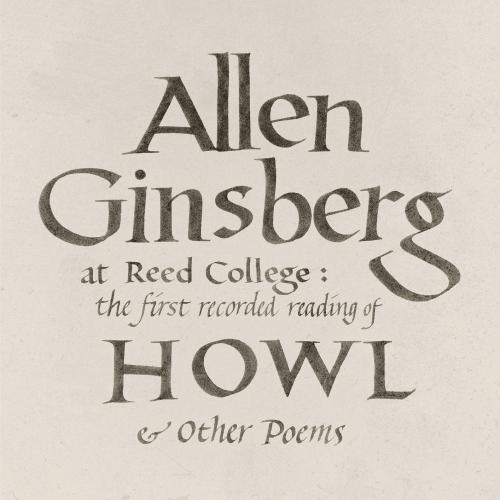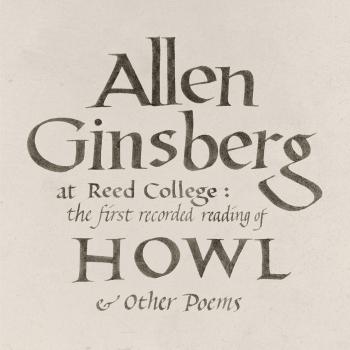
At Reed College: The First Recorded Reading of Howl & Other Poems (Remastered) Allen Ginsberg
Album info
Album-Release:
2021
HRA-Release:
02.04.2021
Album including Album cover
I`m sorry!
Dear HIGHRESAUDIO Visitor,
due to territorial constraints and also different releases dates in each country you currently can`t purchase this album. We are updating our release dates twice a week. So, please feel free to check from time-to-time, if the album is available for your country.
We suggest, that you bookmark the album and use our Short List function.
Thank you for your understanding and patience.
Yours sincerely, HIGHRESAUDIO
- 1 Epithalamion (Later published as Love Poem On Theme By Whitman) 01:45
- 2 Wild Orphan 01:16
- 3 Over Kansas 04:37
- 4 A Dream Record 02:20
- 5 Blessed Be The Muses 00:14
- 6 A Supermarket In California 02:25
- 7 The Trembling Of The Veil (Later titled Transcription Of Organ Music) 04:36
- 8 Introduction 01:19
- 9 Howl 13:39
- 10 Line Pick UP 01:11
- 11 Howl (Part II) 01:16
Info for At Reed College: The First Recorded Reading of Howl & Other Poems (Remastered)
Recorded in 1956 and discovered in 2007, one of the most important audio documents in the history of American literature, from the second half of the 20th century, is available to be heard far and wide in 2021. Allen Ginsberg's first public reading of his epic poem "Howl" took place in October of 1955 at the famous Six Gallery in San Francisco. In attendance that night were Gary Snyder, Philip Whalen, Lawrence Ferlinghetti, Philip Lamantia, Michael McClure, Kenneth Rexroth, Jack Kerouac and Neal Cassady. Imagine if that evening's readings been recorded! It was long thought that the first recorded reading of "Howl" was the March 1956 reading in Berkeley, California; however, prior to that evening, Ginsberg travelled to Reed College in Portland, Oregon, with Gary Snyder for a series of readings. Reed College, a small liberal arts college founded in 1908 and known for it's academic excellence had been attended by the likes of Steve Jobs, Barry Hansen (Dr. Demento), Barbara Ehrenreich, Ry Cooder, Max Gordon (founder of The Village Vanguard), and poet Gary Snyder.
Allen Ginsberg
Digitally remastered
Allen Ginsberg
Renowned poet, world traveler, spiritual seeker, founding member of a major literary movement, champion of human and civil rights, photographer and songwriter, political gadfly, teacher and co-founder of a poetics school. Allen Ginsberg (1926-1997) defied simple classification.
Poets are commonly known only within their circles of readerships but like Walt Whitman, Ginsberg’s name was recognizable to millions who had never read so much as a single word of his poetry. Like Whitman, the foundation of Ginsberg’s work was the notion that one’s individual thoughts and experiences resonated among the masses. “It occurs to me that I am America”, Ginsberg wrote, and while the statement was intended to be humorous, it also illustrated his idea that democracy begins with the raising of a single voice. At the height of his celebrity, Allen Ginsberg was, arguably, as symbolic of America — or at least a large segment of the country — as anyone.
As a poet, he will probably be remembered most for two lengthy masterworks: “Howl”, with its famous opening line (“I saw the best minds of my generation destroyed by madness”) and relentless, rhythmic litany of lines devoted to the celebration of those minds, and “Kaddish” the powerful, heartbreaking biography of his mother, Naomi Ginsberg, who spent most of her adult life in a state of mental torment.
…the foundation of Ginsberg’s work was the notion that one’s individual thoughts and experiences resonated among the masses.
Other poems illustrate Ginsberg’s expansive interests and styles: “Sunflower Sutra” (Ginsberg’s ode to the beauty of the individual); “America” (a savagely comic commentary on American values); “Wichita Vortex Sutra” (a political diatribe in which Ginsberg individually declares an end to the Vietnam War); “Wales Visitation” (a celebration of nature’s minute particulars); the interconnected poems of The Fall of America, which won Ginsberg the National Book Award; “Father Death Blues” (a moving tribute to his father, poet Louis Ginsberg); and “White Shroud” (a dream poem in which the poet finally resolves some of his ambivalent feelings about his mother). And these are only a few of the many highlights. The overall body of Ginsberg’s work remains one of the most impressive literary canons in American history.
The 1956 publication of Howl and Other Poems established Ginsberg as an important voice in American poetry. But Ginsberg would achieve international fame a year later with the highly publicized “Howl” obscenity trial in San Francisco and the publication of Jack Kerouac’s “On the Road”. Kerouac, a Ginsberg friend and mentor since the mid-1940s, had written a novel that defined a generation of youths seeking experience, kicks, enlightenment, self-definition, and meaning in a dull, spiritless society. In such books as Howl, On the Road, and William S. Burroughs’ Naked Lunch, the Beat Generation had its own literature. Kerouac, dubbed “King of the Beats” by a cynical press, was a reluctant spokesperson. Ginsberg, who understood the currency of publicity from his youthful days as a marketing researcher, embraced his role as the Beat Generation’s most eloquent and persistent spokesperson.
I saw the best minds of my generation destroyed by madness
Known for his prodigious energy, Ginsberg labored tirelessly to promote not only his own work, but also the writings of Kerouac, Burroughs, and many others associated with the Beat Generation, including Gregory Corso, Gary Snyder, Michael McClure, Diane di Prima, Philip Whalen, Lawrence Ferlinghetti, and Neal Cassady. In 1973, he and poet Anne Waldman co-founded the Jack Kerouac School of Disembodied Poetics at the Naropa Institute in Boulder, Colorado, ensuring a continuing legacy of the study and practice of Beat Generation-influenced writings.
The “Howl” obscenity trial served as a catalyst in fomenting Ginsberg’s lifelong obsession with First Amendment issues in particular, and political activism in general. Using his fame as an international podium, Ginsberg spoke out on such controversial issues as the Vietnam War, gay rights (he listed his lifelong companion, Peter Orlovsky, as his spouse in his Who’s Who entry), and drugs (he was an early participant in Timothy Leary’s psilocybin and LSD experiments). At times, his opinions landed him in trouble: he was expelled from Cuba and Czechoslovakia in 1965 and, like many outspoken artists and activists, became the subject of a voluminous FBI dossier. His opinions and knowledge, however controversial, were highly solicited. He testified before Senate subcommittee hearings on drugs and his political essays were in constant demand. Accredited with coining the term “Flower Power”, Ginsberg became a figurehead of the global youth movement in the late 1960s.
Ginsberg eventually parlayed his fame and network of connections into a modestly successful career in music. He recorded a handful of albums, including music he had written to accompany William Blake’s Songs of Innocence and Songs of Experience and two separate recordings known as First Blues. He and neo-classical composer Philip Glass set portions of “Howl” and “Wichita Vortex Sutra” to music. Over the years, Ginsberg appeared on stage with a diverse group of musicians, including Bob Dylan, The Fugs, Phil Ochs, the Clash and Patti Smith. Shortly before his death, Ginsberg recorded “Ballad of the Skeletons” with an eclectic lineup of musicians that included Glass, Lenny Kaye, Marc Ribot and Paul McCartney; the accompanying video, filmed by award-winning director Gus Van Sant, was both humorous and poignant.
Ginsberg might have been an American by birth, but through his extensive travel he developed a global consciousness that greatly affected his writings and viewpoint. He spent extended periods of time in Mexico, South America, Europe and India. He visited every continent in the world and every state in the United States and some of his finest work came about as a result of these travels. His interests in Eastern religions, largely influenced by his friendships with Jack Kerouac, Gary Snyder, and Philip Whalen, ultimately led to his adopting formal Buddhist vows.
Somehow celebrity never seemed to faze Ginsberg. He might have once quipped “I want to be known as the most brilliant man in America”, but he spent his nearly seventy-one years trying to earn wisdom the way others attempt to acquire wealth; possessions meant little. He lived modestly, buying his clothing in second-hand stores and residing in downscale apartments in New York’s East Village. He donated much of his income to the Committee on Poetry, a non-profit organization that he organized to assist struggling artists and writers.
The life and writings of Allen Ginsberg continue to be of great interest today — long after he succumbed to liver cancer in 1997. Almost all of his books remain in print. Four books of writings and interviews have been posthumously published and new volumes of journals and correspondence are forthcoming. His poems appear regularly in anthologies around the world, and his photographs are constantly recycled in books and magazines. Universities offer Ginsberg and Beat Generation courses.
But most important — as Ginsberg would likely have seen it — is the fact that every day, somewhere in the world, perhaps in a farm town in Nebraska, or in a café in Berlin, or in a village in Southeast Asia, some kid is picking up “Howl and Other Poems” and beginning the next journey down the corridors of imagination from which a more patient and generous world just might evolve. (Michael Schumacher)
This album contains no booklet.















